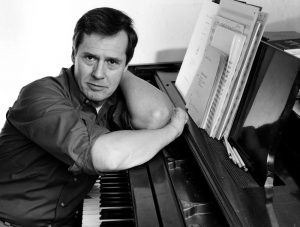Ned Rorem met Eugene Istomin in 1942 when he came to study at the Curtis Institute. By coincidence, the room which Rorem was renting was just above Istomin’s apartment. In his book Knowing When To Stop, he painted an amusing portrait of Istomin as “a dusky, worried cherub with a social stance that combined warmth and hauteur in equal doses.” And he added: “For now he was winding up the scholastic year, practicing all day, dining always at L’Aiglon nearby, where his father was maître d’hôtel, reading heavy stuff (Thomas Mann, Leibniz & Russell’s and Whitehead’s Principia Mathematica) and going to movies. (…) He knew his worth at seventeen, a master pianist already, he never improved, and I mean this as a compliment. Great interpreters don’t progress — except sometimes negatively, the way a cancer progresses — so much as expand or contract repertorially; they are what they are by mid-adolescence, because excellence and comprehension don’t come with age, they’re inborn. (…) During that year I heard Eugene practice and perform for hundreds of hours. His nature became my second nature. I myself am hardly a great pianist but I am a good impersonator; when people comment on my pianism, I say: ‘I can’t play at all, I’m doing an imitation of Eugene.’ The artistry of Eugene Istomin has influenced the way I approach all music, even music he despises.” In October 1943, when Istomin won the Philadelphia Orchestra Youth Contest, Ned Rorem accompanied him on the second piano.
Shortly after the end of World War Two, Istomin, who was then socializing in the avant-garde milieu of Manhattan, met Paul Goodman through Ned Rorem. Goodman attained notoriety only in the early 60s, when he became one of the gurus of the American protest movements. At that time, his poems, novels and essays were published in anarchist reviews or by marginal editors. His taste for originality at any cost and his desire to break with tradition and to shock had appealed to Rorem and made him deeply change his way of thinking and living. Some of Rorem’s most beautiful songs were composed on Goodman’s poems.
Ned Rorem always remembered a particular night of 1947: “John Myers was madly trying to turn Mary’s Bar on 8th Street into another Boeuf sur le Toit. For the opening Paul and I concocted three blues which John and Frank Etherton intoned in the styles of Mistinguett and Stella Brooks. Heartbreaking -but hardly the speed of that clientele. At 2 a.m. Eugene Istomin took over the keyboard of an upright casserole and amidst the fumes of laughter and beer performed Gaspard de la Nuit. Incredibly, that was the speed of the clientele. Next day Paul made his first-class translation of the second-class prose-poems, by one Aloysius Bertrand, which had first inspired Ravel’s piano cycle, and for years Istomin reprinted these translations in the program of his international tours.”
Meetings, events, reunions, and celebrations punctuated the sixty years of an unclouded friendship. Istomin often regretted not having performed the works of his friend often enough, but Rorem never held it against him. In 1948, he composed a piano concerto for Istomin, but he soon considered it to be an unaccomplished attempt which was only fit to be burnt! In 1956, Istomin performed a Burlesque, written especially for him by Ned Rorem, throughout an extensive concert tour of the Far East. Once again, the composer was not satisfied. He decided against publishing it and reused the theme in his Organ Variations, A Quaker Reader. In 1971, Istomin recorded two song cycles set by Rorem on poems of Walt Whitman with baritone Donald Gramm. One of them, War Scenes, was dedicated “To those who died in Vietnam, both sides” and had just been premiered by Gérard Souzay. Istomin admired Rorem’s great talent as a melodist and his ability to set to music a very large range of texts, from the darkest drama to the funniest cabaret song. As James Gollin writes in his biography of Istomin, even fifty years later “the outrageous lyrics and jerky ragtime piano rhythms of Jailbait Blues had the power forever to make Eugene, singing along croakily and vamping at the keyboard, burst into uncontrollable laughter.”
In 1987, in the Piano Festival of Maryland University, Istomin scheduled a small Rorem festival and commissioned a piece by him for the Kapell Competition. Rorem sent Song and Dance in October 1986, introduced by these words: ”It’s an A-B-A (hard-easy-hard) showpiece for piano solo. Musically the piece is what it is: spicily ugly and flashy, cornily touching and sicilienne-ish, then spikey again.”
Until Istomin’s death, they continued to exchange affectionate notes and phone calls, like this message on November 15, 1998: “Dear Eugene, I can’t tell you how moved I was by your call from Paris yesterday. It’s a melancholic time for me these months, and I feel very close to your nostalgia, as you – as we all – dip into a never-to-be-retrieved past, yet a past which paradoxically is always present. Je t’aime. Ned.”
On November 26, 2000, for Isaac Stern’s 80th birthday, Rorem revealed that one of his most precious sources of inspiration had been “Eugene’s own mother, Feera, who so beautifully sang Russian folk tunes to her son’s able accompaniment.”
Music
Ned Rorem. Inauguration Ball (from War Scenes, texts by Walt Whitman). Donald Gramm, bass-baritone. Eugene Istomin. Recorded in 1969 (CD Phoenix 116)
.
Ned Rorem. Symphony No. 3. New York Philharmonic, Leonard Bernstein (world premiere performance on April 18, 1959 – sound only). This work was mainly inspired by his love for France, a love which he shared with Istomin.






